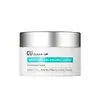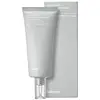What's inside
What's inside
 Key Ingredients
Key Ingredients

 Benefits
Benefits

 Concerns
Concerns

 Ingredients Side-by-side
Ingredients Side-by-side

Water
Skin ConditioningGlycerin
HumectantDimethicone
EmollientDipropylene Glycol
HumectantPolyglyceryl-3 Methylglucose Distearate
EmulsifyingCaprylic/Capric Triglyceride
MaskingSorbitan Olivate
EmulsifyingPropanediol
SolventButylene Glycol
HumectantCetearyl Olivate
Butylene Glycol Dicaprylate/Dicaprate
EmollientMacadamia Ternifolia Seed Oil
EmollientSoy Isoflavones
Skin ConditioningPanthenol
Skin ConditioningCeramide NP
Skin ConditioningGlyceryl Glucoside
HumectantSodium Hyaluronate
HumectantPolyglutamic Acid
Skin ConditioningNiacinamide
SmoothingMethionine
Skin ConditioningEchium Plantagineum Seed Oil
Skin ConditioningArgania Spinosa Kernel Oil
EmollientSesamum Indicum Seed Oil
EmollientHydrogenated Lecithin
EmulsifyingHelianthus Annuus Seed Oil Unsaponifiables
EmollientEthylhexylglycerin
Skin ConditioningGlucose
HumectantLactobacillus/Soybean Ferment Extract
Skin ConditioningLactobacillus/Punica Granatum Fruit Ferment Extract
Skin ConditioningSaccharomyces/Barley Seed Ferment Filtrate
HumectantLactobacillus/Pear Juice Ferment Filtrate
Skin ConditioningCentella Asiatica Extract
CleansingScutellaria Baicalensis Root Extract
AstringentPaeonia Suffruticosa Root Extract
Skin ProtectingPolygonum Cuspidatum Root Extract
AntioxidantCamellia Sinensis Leaf Extract
AntimicrobialGlycyrrhiza Glabra Root Extract
BleachingChamomilla Recutita Flower Extract
MaskingRosmarinus Officinalis Leaf Extract
AntimicrobialAloe Barbadensis Leaf Extract
EmollientCardiospermum Halicacabum Flower/Leaf/Vine Extract
Skin ConditioningSerenoa Serrulata Fruit Extract
Skin ConditioningBeta-Sitosterol
Emulsion StabilisingCyclopentasiloxane
EmollientLecithin
EmollientAllantoin
Skin ConditioningSerine
MaskingHistidine
HumectantCarbomer
Emulsion StabilisingSodium Acrylates Copolymer
Dimethicone/Vinyl Dimethicone Crosspolymer
Skin ConditioningOctyldodecanol
EmollientCyclohexasiloxane
EmollientC14-22 Alcohols
Emulsion StabilisingPolyglyceryl-10 Myristate
Skin Conditioning1,2-Hexanediol
Skin ConditioningC12-20 Alkyl Glucoside
EmulsifyingDipotassium Glycyrrhizate
HumectantHydroxyethylcellulose
Emulsion StabilisingArginine
MaskingTocopherol
AntioxidantMaltodextrin
AbsorbentParfum
MaskingWater, Glycerin, Dimethicone, Dipropylene Glycol, Polyglyceryl-3 Methylglucose Distearate, Caprylic/Capric Triglyceride, Sorbitan Olivate, Propanediol, Butylene Glycol, Cetearyl Olivate, Butylene Glycol Dicaprylate/Dicaprate, Macadamia Ternifolia Seed Oil, Soy Isoflavones, Panthenol, Ceramide NP, Glyceryl Glucoside, Sodium Hyaluronate, Polyglutamic Acid, Niacinamide, Methionine, Echium Plantagineum Seed Oil, Argania Spinosa Kernel Oil, Sesamum Indicum Seed Oil, Hydrogenated Lecithin, Helianthus Annuus Seed Oil Unsaponifiables, Ethylhexylglycerin, Glucose, Lactobacillus/Soybean Ferment Extract, Lactobacillus/Punica Granatum Fruit Ferment Extract, Saccharomyces/Barley Seed Ferment Filtrate, Lactobacillus/Pear Juice Ferment Filtrate, Centella Asiatica Extract, Scutellaria Baicalensis Root Extract, Paeonia Suffruticosa Root Extract, Polygonum Cuspidatum Root Extract, Camellia Sinensis Leaf Extract, Glycyrrhiza Glabra Root Extract, Chamomilla Recutita Flower Extract, Rosmarinus Officinalis Leaf Extract, Aloe Barbadensis Leaf Extract, Cardiospermum Halicacabum Flower/Leaf/Vine Extract, Serenoa Serrulata Fruit Extract, Beta-Sitosterol, Cyclopentasiloxane, Lecithin, Allantoin, Serine, Histidine, Carbomer, Sodium Acrylates Copolymer, Dimethicone/Vinyl Dimethicone Crosspolymer, Octyldodecanol, Cyclohexasiloxane, C14-22 Alcohols, Polyglyceryl-10 Myristate, 1,2-Hexanediol, C12-20 Alkyl Glucoside, Dipotassium Glycyrrhizate, Hydroxyethylcellulose, Arginine, Tocopherol, Maltodextrin, Parfum
Water
Skin ConditioningGlycerin
HumectantCaprylic/Capric Triglyceride
MaskingButylene Glycol
HumectantPropanediol
SolventStearic Acid
CleansingCetearyl Alcohol
EmollientMethyl Trimethicone
Skin ConditioningCaprylyl Methicone
Skin Conditioning1,2-Hexanediol
Skin ConditioningC12-16 Alcohols
EmollientPanthenol
Skin ConditioningOlea Europaea Fruit Oil
MaskingDipropylene Glycol
HumectantAllantoin
Skin ConditioningPantolactone
HumectantMalt Extract
Skin ProtectingCeramide EOP
Skin ConditioningCeramide Ns
Skin ConditioningCeramide NP
Skin ConditioningCeramide As
Skin ConditioningCeramide AP
Skin ConditioningSodium Hyaluronate
HumectantHeptasodium Hexacarboxymethyl Dipeptide-12
Skin ConditioningPhytosphingosine
Skin ConditioningArachidic Acid
CleansingOleic Acid
EmollientPalmitic Acid
EmollientGlyceryl Stearate Se
EmulsifyingHydrogenated Lecithin
EmulsifyingXanthan Gum
EmulsifyingCarbomer
Emulsion StabilisingGlucose
HumectantCetearyl Glucoside
EmulsifyingEthylhexylglycerin
Skin ConditioningCholesterol
EmollientTocopherol
AntioxidantTromethamine
BufferingDisodium EDTA
Water, Glycerin, Caprylic/Capric Triglyceride, Butylene Glycol, Propanediol, Stearic Acid, Cetearyl Alcohol, Methyl Trimethicone, Caprylyl Methicone, 1,2-Hexanediol, C12-16 Alcohols, Panthenol, Olea Europaea Fruit Oil, Dipropylene Glycol, Allantoin, Pantolactone, Malt Extract, Ceramide EOP, Ceramide Ns, Ceramide NP, Ceramide As, Ceramide AP, Sodium Hyaluronate, Heptasodium Hexacarboxymethyl Dipeptide-12, Phytosphingosine, Arachidic Acid, Oleic Acid, Palmitic Acid, Glyceryl Stearate Se, Hydrogenated Lecithin, Xanthan Gum, Carbomer, Glucose, Cetearyl Glucoside, Ethylhexylglycerin, Cholesterol, Tocopherol, Tromethamine, Disodium EDTA
 Reviews
Reviews

Ingredients Explained
These ingredients are found in both products.
Ingredients higher up in an ingredient list are typically present in a larger amount.
1,2-Hexanediol is a synthetic liquid and another multi-functional powerhouse.
It is a:
- Humectant, drawing moisture into the skin
- Emollient, helping to soften skin
- Solvent, dispersing and stabilizing formulas
- Preservative booster, enhancing the antimicrobial activity of other preservatives
Allantoin is a soothing ingredient known for its protective and moisturizingg properties. Because of this, it is often added to products with strong active ingredients.
Studies show higher concentrations of this ingredient can promote wound healing.
Though it can be derived from the comfrey plant, allantoin is produced synthetically for cosmetic products to ensure purity.
Learn more about AllantoinButylene Glycol (or BG) is used within cosmetic products for a few different reasons:
Overall, Butylene Glycol is a safe and well-rounded ingredient that works well with other ingredients.
Though this ingredient works well with most skin types, some people with sensitive skin may experience a reaction such as allergic rashes, closed comedones, or itchiness.
Learn more about Butylene GlycolThis ingredient is an emollient, solvent, and texture enhancer. It is considered a skin-softener by helping the skin prevent moisture loss.
It helps thicken a product's formula and makes it easier to spread by dissolving clumping compounds.
Caprylic Triglyceride is made by combining glycerin with coconut oil, forming a clear liquid.
While there is an assumption Caprylic Triglyceride can clog pores due to it being derived from coconut oil, there is no research supporting this.
Learn more about Caprylic/Capric TriglycerideCarbomer is a polymer of acrylic acid. Its main role is to create a gel consistency.
A high amount of carbomer can cause pilling or balling up of products. Don't worry, most products contain 1% or less of carbomer.
Ceramide NP is a type of ceramide and formally known as ceramide 3.
Ceramides are intercellular lipids naturally found in our skin that bonds dead skin cells together to create a barrier. They are known for their ability to hold water and thus are a great ingredient for dry skin.
Ceramides are an important building block for our skin barrier. A stronger barrier helps the skin look more firm and hydrated. By bolstering the skin ceramides act as a barrier against irritating ingredients. This can help with inflammation as well.
If you would like to eat ceramides, sweet potatoes contain a small amount.
Read more about other common types of ceramides here:
Ceramide AP
Ceramide EOP
Dipropylene Glycol is a synthetically created humectant, stabilizer, and solvent.
This ingredient helps:
Dipropylene glycol is technically an alcohol, but it belongs to the glycol family (often considered part of the ‘good’ alcohols). This means it is hydrating and gentle on skin unlike drying solvent alcohols like denatured alcohol.
As a masking agent, Dipropylene Glycol can be used to cover the smell of other ingredients. However, it does not have a scent.
Studies show Dipropylene Glycol is considered safe to use in skincare.
Learn more about Dipropylene GlycolEthylhexylglycerin (we can't pronounce this either) is commonly used as a preservative and skin softener. It is derived from glyceryl.
You might see Ethylhexylglycerin often paired with other preservatives such as phenoxyethanol. Ethylhexylglycerin has been found to increase the effectiveness of these other preservatives.
Glucose is a simple sugar and is the most important source of energy in all organisms.
In skincare, glucose is used to hydrate the skin. It also acts as a prebiotic for our natural biome.
Glucose is hydrating due to its humectant property. As a humectant, glucose draws moisture from the air and from deeper levels in the skin.
Our skin contains many sugars that act as prebiotics and help strengthen our natural microbiome. Having a healthy microbiome helps protect our skin from harmful bacteria and other contaminants.
Studies show glucose may help with fading discoloration and pigmentation. This is because our skin metabolizes glucose into lactic acid. Lactic acid is an AHA that helps exfoliate the top layer of skin.
Learn more about GlucoseGlycerin is already naturally found in your skin. It helps moisturize and protect your skin.
A study from 2016 found glycerin to be more effective as a humectant than AHAs and hyaluronic acid.
As a humectant, it helps the skin stay hydrated by pulling moisture to your skin. The low molecular weight of glycerin allows it to pull moisture into the deeper layers of your skin.
Hydrated skin improves your skin barrier; Your skin barrier helps protect against irritants and bacteria.
Glycerin has also been found to have antimicrobial and antiviral properties. Due to these properties, glycerin is often used in wound and burn treatments.
In cosmetics, glycerin is usually derived from plants such as soybean or palm. However, it can also be sourced from animals, such as tallow or animal fat.
This ingredient is organic, colorless, odorless, and non-toxic.
Glycerin is the name for this ingredient in American English. British English uses Glycerol/Glycerine.
Learn more about GlycerinHydrogenated Lecithin is created from the hydrogenation of lecithin (a group of phospholipids). Hydrogenation is a chemical reaction between hydrogen and another element.
This ingredient is an emollient and emulsifier. As an emollient, it helps soften skin by trapping moisture within. As an emulsifier, it prevents oil and water ingredients from separating.
Panthenol is a common ingredient that helps hydrate and soothe the skin. It is found naturally in our skin and hair.
There are two forms of panthenol: D and L.
D-panthenol is also known as dexpanthenol. Most cosmetics use dexpanthenol or a mixture of D and L-panthenol.
Panthenol is famous due to its ability to go deeper into the skin's layers. Using this ingredient has numerous pros (and no cons):
Like hyaluronic acid, panthenol is a humectant. Humectants are able to bind and hold large amounts of water to keep skin hydrated.
This ingredient works well for wound healing. It works by increasing tissue in the wound and helps close open wounds.
Once oxidized, panthenol converts to pantothenic acid. Panthothenic acid is found in all living cells.
This ingredient is also referred to as pro-vitamin B5.
Learn more about PanthenolPropanediol is an all-star ingredient. It softens, hydrates, and smooths the skin.
It’s often used to:
Propanediol is not likely to cause sensitivity and considered safe to use. It is derived from corn or petroleum with a clear color and no scent.
Learn more about PropanediolSodium Hyaluronate is hyaluronic acid's salt form. It is commonly derived from the sodium salt of hyaluronic acid.
Like hyaluronic acid, it is great at holding water and acts as a humectant. This makes it a great skin hydrating ingredient.
Sodium Hyaluronate is naturally occurring in our bodies and is mostly found in eye fluid and joints.
These are some other common types of Hyaluronic Acid:
Learn more about Sodium HyaluronateTocopherol (also known as Vitamin E) is a common antioxidant used to help protect the skin from free-radicals and strengthen the skin barrier. It's also fat soluble - this means our skin is great at absorbing it.
Vitamin E also helps keep your natural skin lipids healthy. Your lipid skin barrier naturally consists of lipids, ceramides, and fatty acids. Vitamin E offers extra protection for your skin’s lipid barrier, keeping your skin healthy and nourished.
Another benefit is a bit of UV protection. Vitamin E helps reduce the damage caused by UVB rays. (It should not replace your sunscreen). Combining it with Vitamin C can decrease sunburned cells and hyperpigmentation after UV exposure.
You might have noticed Vitamin E + C often paired together. This is because it is great at stabilizing Vitamin C. Using the two together helps increase the effectiveness of both ingredients.
There are often claims that Vitamin E can reduce/prevent scarring, but these claims haven't been confirmed by scientific research.
Learn more about TocopherolWater. It's the most common cosmetic ingredient of all. You'll usually see it at the top of ingredient lists, meaning that it makes up the largest part of the product.
So why is it so popular? Water most often acts as a solvent - this means that it helps dissolve other ingredients into the formulation.
You'll also recognize water as that liquid we all need to stay alive. If you see this, drink a glass of water. Stay hydrated!
Learn more about Water